Nikon AF-S DX Nikkor 10-24mm f/3.5-4.5G ED Lens
Nikon AF-S DX Nikkor 10-24mm f/3.5-4.5G ED Performance
At 10mm, sharpness in the centre of the frame is already excellent at maximum aperture and this clarity holds up well towards the edges of the frame. In the far corners a little softness can be seen at maximum aperture, but this disappears as the lens is stopped down beyond f/5.6 where sharpness across the frame is outstanding.At 15mm overall sharpness drops a little, but it still remains excellent in the central portion of the frame. Clarity towards the edges is still very good, but just the same as at 10mm, the far corners are visibly softer. Again this phenomenon disappears as the lens is stopped down and peak quality across the frame is achieved at f/8.
Finally at 24mm, the excellent centre sharpness is mantained, but the quality towards the edges of the frame drops off noticeably. Stopping down improves matters considerably towards the edges, with peak performance being achieved between f/5.6 and f/8.
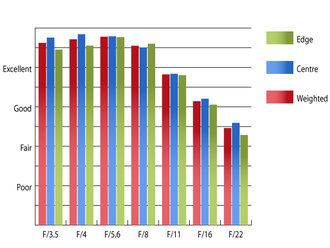 Resolution @ 10mm | 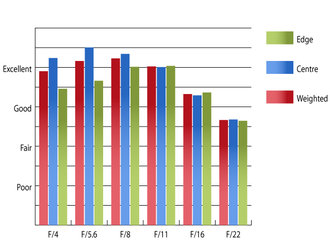 Resolution @ 15mm | |
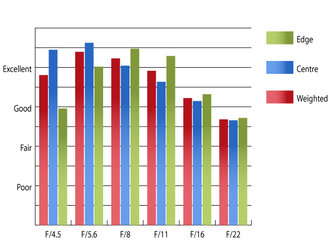 Resolution @ 24mm | How to read our chartsThe blue column represents readings from the centre of the picture frame at the various apertures and the green is from the edges. Averaging them out gives the red weighted column.The scale on the left side is an indication of actual image resolution. The taller the column, the better the lens performance. Simple. For this review, the lens was tested on a Nikon D300 using Imatest. |
Chromatic aberrations can be visible on close inspection in high contrast areas towards the edges of the frame at 10mm. Here Imatest recorded levels exceeding 0.75 pixel widths, which is just acceptable. This level of CA is fairly constant throughout the zoom range, only dropping off slightly at 24mm.
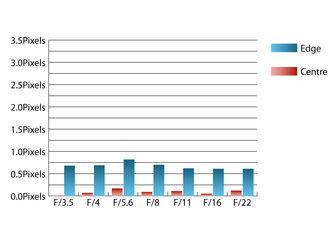 Chromatic aberration @ 10mm | 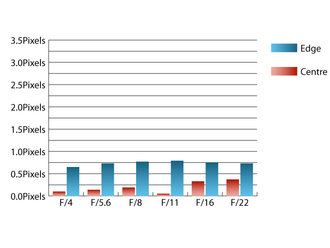 Chromatic aberration @ 15mm | |
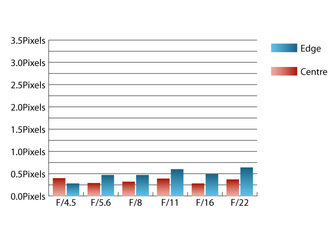 Chromatic aberration @ 24mm | How to read our chartsChromatic aberration is the lens' inability to focus on the sensor or film all colours of visible light at the same point. Severe chromatic aberration gives a noticeable fringing or a halo effect around sharp edges within the picture. It can be cured in software.Apochromatic lenses have special lens elements (aspheric, extra-low dispersion etc) to minimize the problem, hence they usually cost more. For this review, the lens was tested on a Nikon D300 using Imatest. |
Falloff of illumination towards the corners of the frame is incredibly low for an ultra-wide angle lens. Maximum aperture throughout the zoom range the corners are only 0.4stops darker than the image centre and stopping down 2/3 of a stp results in visually uniform illumination.
Most ultra-wides suffer to a certain degree with distortion, and the Nikon 10-24 is no exception. Even so, compared to lenses of a similar focal length the amount of barrel distortion at 10mm, which is 5.87% as recorded by Imatest, is relatively low. At 24mm 0.547% pincushion distortion is present, which will rarely be an issue. The distortion pattern is consistent across the frame, which should make it relatively easy to straighten in image editing software afterwards.
As is the case with many ultra-wide lenses, this 10-24mm optic can be prone to flare, especially with strong light sources in the frame, such as the sun. With a little care this can be avoided quite easily and contrast remains high. A shallow petal shaped hood is provided with the lens, which is of limited use shadeing the front element due to the extreme wide angle of view.
Add your message
Login required
Please login here or if you've not registered, you can register here. Registering is safe, quick and free.
Please login here or if you've not registered, you can register here. Registering is safe, quick and free.
photodo Stats
1102 lenses
428 MTF tests
74 in-depth photodo reviews
100+ users join each day
Help the lens community by reviewing or rating a lens today via our lens search
428 MTF tests
74 in-depth photodo reviews
100+ users join each day
Help the lens community by reviewing or rating a lens today via our lens search
Latest Lens Reviews
- Chinon 28mm f/2.8 Vintage Lens Review
- Canon EF 70-200mm f/4L IS II USM Lens Review
- Samyang AF 85mm f/1.4 EF Review
- Sigma 70mm f/2.8 DG Macro Art Review
- Samyang AF 24mm f/2.8 FE Review
- Meike 50mm f/1.7 Review
- Tamron 70-210mm f/4 Di VC USD Review
- Lensbaby Burnside 35mm f/2.8 Review
- Asahi Super Takumar 50mm f/1.4 Review
- Asahi Super-Multi-Coated Takumar 135mm f/3.5 Review
